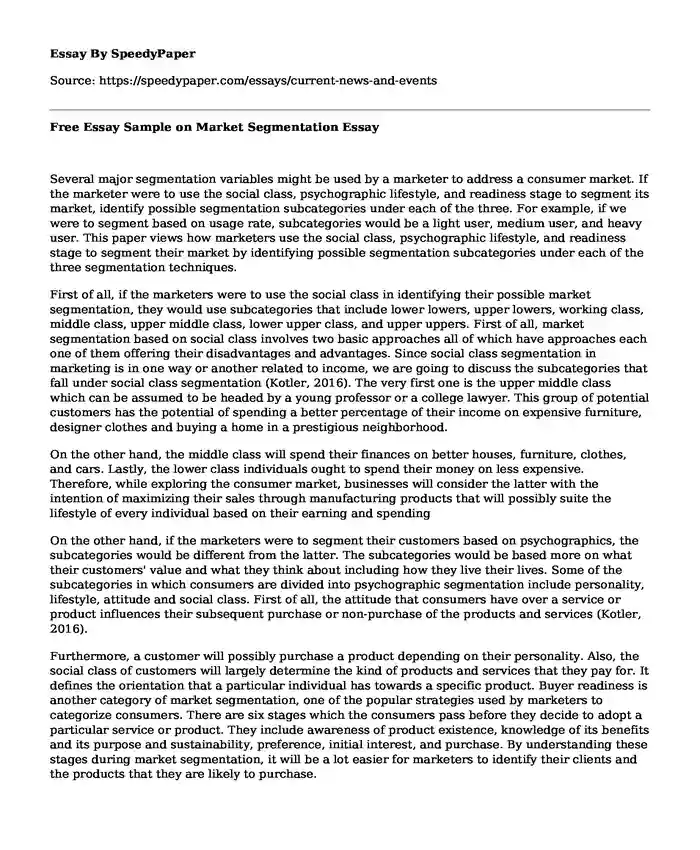Several major segmentation variables might be used by a marketer to address a consumer market. If the marketer were to use the social class, psychographic lifestyle, and readiness stage to segment its market, identify possible segmentation subcategories under each of the three. For example, if we were to segment based on usage rate, subcategories would be a light user, medium user, and heavy user. This paper views how marketers use the social class, psychographic lifestyle, and readiness stage to segment their market by identifying possible segmentation subcategories under each of the three segmentation techniques.
First of all, if the marketers were to use the social class in identifying their possible market segmentation, they would use subcategories that include lower lowers, upper lowers, working class, middle class, upper middle class, lower upper class, and upper uppers. First of all, market segmentation based on social class involves two basic approaches all of which have approaches each one of them offering their disadvantages and advantages. Since social class segmentation in marketing is in one way or another related to income, we are going to discuss the subcategories that fall under social class segmentation (Kotler, 2016). The very first one is the upper middle class which can be assumed to be headed by a young professor or a college lawyer. This group of potential customers has the potential of spending a better percentage of their income on expensive furniture, designer clothes and buying a home in a prestigious neighborhood.
On the other hand, the middle class will spend their finances on better houses, furniture, clothes, and cars. Lastly, the lower class individuals ought to spend their money on less expensive. Therefore, while exploring the consumer market, businesses will consider the latter with the intention of maximizing their sales through manufacturing products that will possibly suite the lifestyle of every individual based on their earning and spending
On the other hand, if the marketers were to segment their customers based on psychographics, the subcategories would be different from the latter. The subcategories would be based more on what their customers' value and what they think about including how they live their lives. Some of the subcategories in which consumers are divided into psychographic segmentation include personality, lifestyle, attitude and social class. First of all, the attitude that consumers have over a service or product influences their subsequent purchase or non-purchase of the products and services (Kotler, 2016).
Furthermore, a customer will possibly purchase a product depending on their personality. Also, the social class of customers will largely determine the kind of products and services that they pay for. It defines the orientation that a particular individual has towards a specific product. Buyer readiness is another category of market segmentation, one of the popular strategies used by marketers to categorize consumers. There are six stages which the consumers pass before they decide to adopt a particular service or product. They include awareness of product existence, knowledge of its benefits and its purpose and sustainability, preference, initial interest, and purchase. By understanding these stages during market segmentation, it will be a lot easier for marketers to identify their clients and the products that they are likely to purchase.
Case Study
If a marketer were to segment a business (not consumer) market on the basis of demographics, what three subcategory segmentation variables would probably be used to assist with this form of segmentation? What questions would be asked in each of the three categories to advance the segmentation effort?
Demographic segmentation refers to the segmentation of the buyer's characteristics such as ethnicity, age income, occupation, nationality family size, social class, and religion. If marketers and not consumers were to segment a business market concerning demographics, three segmentation variables would be used to assist in this form of segmentation. The three main subcategories that would be used include industry, company size, and business location. The industry refers to the type of industry which or rather the type of industries that will be serving a specific business. On the other hand, the size of the company refers to the size of companies in which the business market should serve (Kotler, 2016). Lastly, the location refers to the geographic location which the business market is planning to serve. Some of the questions that would be asked based on location are, the geographical area that the business should serve. The size of the company is another question that the marketers will also and lastly is the kind of industries that need to be served. Through this kind of segmentation, it is possible for marketers and any other involved institution to prepare themselves in a manner that they can produce services and products that meet the needs of their target market.
Reference
Kotler, P., & Keller, K. L. (2006). Marketing management 12e. New Jersey.
Cite this page
Free Essay Sample on Market Segmentation. (2022, Aug 31). Retrieved from https://speedypaper.net/essays/current-news-and-events
Request Removal
If you are the original author of this essay and no longer wish to have it published on the SpeedyPaper website, please click below to request its removal:
- Free Essay in the History of Racism in America
- Essay Example: General Principles of Healthcare Budgeting
- Free Essay Describing Social Problems in the Educational System
- Time Management Journal - Free Example for You
- Fear and Human Behavior - The Modern Day Witch Hunt
- Free Essay Comparing Two Articles on Education
- Free Essay Sample: Independence of the Air Force
Popular categories





